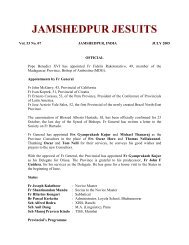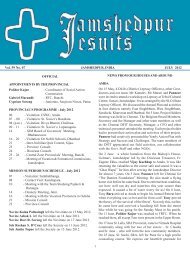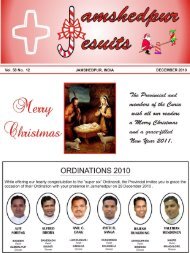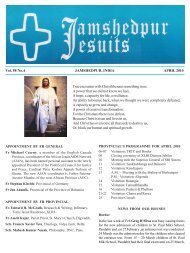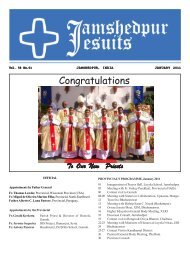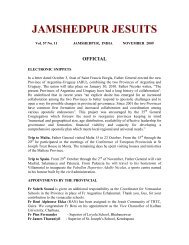Click here to download - Jamshedpur Jesuits
Click here to download - Jamshedpur Jesuits
Click here to download - Jamshedpur Jesuits
Create successful ePaper yourself
Turn your PDF publications into a flip-book with our unique Google optimized e-Paper software.
Christmas Special<br />
Once Christianity was legalized<br />
by the Emperor Constantine with the<br />
Edict of Milan in 313 A.D., these feast<br />
days could be celebrated publicly. This<br />
happened slowly at first. As believers<br />
began <strong>to</strong> share their faith, they realized<br />
that many of them had developed slightly<br />
different traditions. The days on which<br />
saints’ feasts were celebrated did not<br />
always align. Some saints were known<br />
only in their local communities while<br />
some had become famous throughout<br />
the Church.<br />
Pope St. Julius I, whose papacy<br />
ran from 337 <strong>to</strong> 352, worked <strong>to</strong> make<br />
the celebrations of the universal Church<br />
more uniform. Saints’ feasts became part<br />
of the Church calendar, locally in the case<br />
of saints who were known only in a small<br />
area, and universally in situations w<strong>here</strong><br />
the saint’s fame had spread throughout<br />
the Church. And t<strong>here</strong> was one last detail<br />
left <strong>to</strong> Julius: establishing the date of<br />
Christmas.<br />
When Was Jesus Born?: During<br />
the time of Julius I, Christians were still<br />
arguing - sometimes violently - about<br />
whether Jesus was divine. They did<br />
not always agree on the details of his<br />
life, either. One of these details was<br />
the exact date of Jesus’ birth. The Bible<br />
doesn’t mention a date, so t<strong>here</strong> was<br />
no single authority that could end the<br />
controversy.<br />
Several branches of the Church<br />
celebrated the day on different dates,<br />
each of which had its own rationale.<br />
Some tried <strong>to</strong> identify the astronomical<br />
event that led the Magi <strong>to</strong> Bethlehem and<br />
extrapolated the date from t<strong>here</strong>. Others<br />
had ancient traditions that led them <strong>to</strong><br />
celebrate a given date. Several of these<br />
dates clustered around late December<br />
and early January (though some differed<br />
wildly). It fell <strong>to</strong> Pope Julius <strong>to</strong> rule<br />
finally on the date when the Western<br />
Church would celebrate Christ’s birth.<br />
His choice was 25 December.<br />
This was not an arbitrary choice.<br />
In many regions, this date corresponded<br />
closely with when the feast was already<br />
celebrated. T<strong>here</strong> was also a sound<br />
correlation with another feast on the<br />
liturgical calendar. But the single most<br />
persuasive reason for settling on late<br />
December was more political - t<strong>here</strong><br />
was a long-standing Roman celebration<br />
already being observed around<br />
that date.<br />
T h e R o m a n O r i g i n s o f<br />
Christmas: Despite such disastrous<br />
missteps as the destruction of the<br />
Temple, the crucifixion of Jesus and<br />
the use of humans as party lanterns, the<br />
Roman Empire had a vibrant culture.<br />
One of the biggest holidays celebrated<br />
by the Roman people was Saturnalia.<br />
Saturn was the god of sowing, among<br />
other things, so t<strong>here</strong> was some rationale<br />
for appealing <strong>to</strong> him during the shortest<br />
days of the year (the winter solstice falls<br />
on December 21 or 22) in hope that the<br />
sun might return again and provide life<br />
support for that agrarian culture.<br />
Catullus called the Saturnalia<br />
“the best of days” (Catullus 14.15) for<br />
its deep roots in the celebration of the<br />
winter solstice and the rebirth of light<br />
and mirth in the heart of winter. The<br />
festival dates varied through the course<br />
of Roman his<strong>to</strong>ry, but began as the feast<br />
day of Saturn (17 Dec) and his wife, Ops<br />
(19 Dec), both ancient Roman fertility<br />
deities. Saturn was the god of agriculture<br />
(merging later with the Greek god<br />
Kronos) while Ops was the goddess of<br />
plenty and mother earth. During the<br />
Roman Empire the ever-popular festival<br />
was extended <strong>to</strong> seven days, from 17 Dec<br />
through 23 Dec.<br />
In each Roman home, the master<br />
might wait on his own servants, and<br />
one of the slaves was commonly chosen<br />
as Saturnalicius Princeps (Master<br />
of the Saturnalia), who could order<br />
others around in a complete reversal<br />
of roles. On the final day (23 Dec),<br />
everyone exchanged small gifts including<br />
sigillaria(small pottery dolls) for the<br />
children and cerei (small candles) for adults.<br />
In the middle of winter:<br />
Although the cultural observance of<br />
Saturnalia may have influenced the<br />
decision <strong>to</strong> set the date for Christmas<br />
on 25 Dec, celebrating the birth of<br />
Christ in the middle of winter makes<br />
perfect sense. Christ is the intersection<br />
of all things. He brings the light in<strong>to</strong> the<br />
darkness - when better <strong>to</strong> remember this<br />
than during winter’s longest nights? He<br />
brings eternity in<strong>to</strong> time - how better<br />
<strong>to</strong> be mindful of this than <strong>to</strong> see the<br />
traces of ancient practices in our modern<br />
celebrations?<br />
What better moment <strong>to</strong> reflect on<br />
both the brevity and great expanse of<br />
time than at the close of one year and<br />
the beginning of the next? And Christ<br />
is the intersection of East and West -<br />
the skygazing mystics of the East came<br />
<strong>to</strong> honor him; his birth occurred in<br />
Bethlehem because his parents traveled<br />
t<strong>here</strong> <strong>to</strong> be counted for the Roman<br />
census. To situate the celebration of his<br />
birth between the ancient date of 6 Jan,<br />
used in the Eastern Church, and the<br />
Roman winter festival combines the<br />
best of both.<br />
The selection of 25 Dec as the date<br />
for Christmas is a profound reminder <strong>to</strong><br />
us that ordinary things do not somehow<br />
“corrupt” what is holy. On the contrary,<br />
the Incarnation elevated this material<br />
world - and especially our human nature<br />
- <strong>to</strong> a new level of sanctity. The Church<br />
does not minimize Christmas by locating<br />
it on the date of a pagan feast; rather, it<br />
elevates that feast and the people who<br />
celebrated light and life and family in<br />
the centuries before Christ. It remembers<br />
that, though they did not have the same<br />
opportunity <strong>to</strong> believe in Jesus that we<br />
have <strong>to</strong>day, they knew and honored<br />
what was best about humanity - the<br />
very humanity for whom Christ did not<br />
hesitate <strong>to</strong> die.<br />
Jesus might have been born in the<br />
middle of May, for all we know from<br />
Scripture, but I agree with Pope Julius<br />
I - the quiet of winter is the best time <strong>to</strong><br />
remember the occasion.<br />
How does Christmas remind you<br />
of the sanctity of ordinary things? This<br />
Christmas as you decorate a common<br />
tree with even more common tinsel,<br />
consider how the birth of Jesus has<br />
changed everything.<br />
- Excerpted from A Catholic Christmas,<br />
by Kathleen M. Carroll, St. Anthony Messenger<br />
Press, ©2011.<br />
•<br />
Courtesy: http://www.americancatholic.org<br />
JIVAN: News and Views of <strong>Jesuits</strong> in India NOVEMBER-DECEMBER 2012 24



